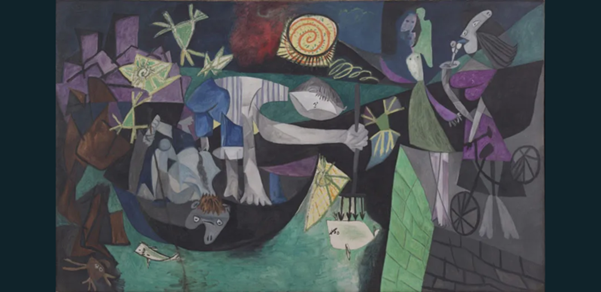
© Sucesión Picasso, VEGAP, Madrid, 2023
The work Night Fishing in Antibes is an oil painting by Pablo Picasso in the summer of 1939. Picasso was living in France during the Spanish Civil War, where he had been living since 1904. He spent the summer of 1939 in a small southern French town, Antibes, where he painted this work. That same year coincides with the end of the civil war and, although Picasso had not been to his native country for several years, this war marks the work and life of the artist. We can see it in Night Fishing in Antibes and in other productions of his.
During his stay in Antibes, he lives with Dora Mar, his partner at the time. Here they used to walk along the pier, the main inspiration for this work and, in addition, several large paintings were made, this painting being the largest after Guernica (1937).
As Steven A. Nash explains in the book Picasso and the war years 1937 - 1945, the work is loaded with symbolism that allows us to know the situation and feelings of the artist during the complicated historical reality that he had to live. The lighting and the colors used (black, dark blue and purple) transport us to a dreamlike reality. Two fishermen are represented in the work, the spear carried by one of them is the center of the composition that is stuck in the fish. This representation transports us to the idea of death, which in turn is related to the moment of war, tension and uncertainty that the artist is living.
The two women who appear in the work represent excitement and death, we know this from the references used: pointed forked tongue and phallic-shaped head (Picasso used to relate sexual symbolism with death. In this work we can see the fear that Pablo Picasso feels after the Civil War (1936-1939) and before the imminent Great War (1939-1945), the second he would have to live.
The work was exhibited at the Louis Carré gallery in Paris, this being the artist's first personal exhibition after World War II, according to Josep Palau i Fabre (2019) in his book Dear Picasso. This work, along with the work Woman - flower (1946) are the two pieces that most attracted his attention. It is currently in the MoMA (The Museum of Modern Arts).
References:
- Nash, N. A., & Rosenblum, R. (1998). Picasso and the war years 1937 - 1945. Thames & Hudson/Fine Arts Museums of San Francisco.
- Palau I Fabre, J. P. (2019). Dear Picasso. Ed. Julià Guillamon. Editorial Galaxia Gutenberg.

